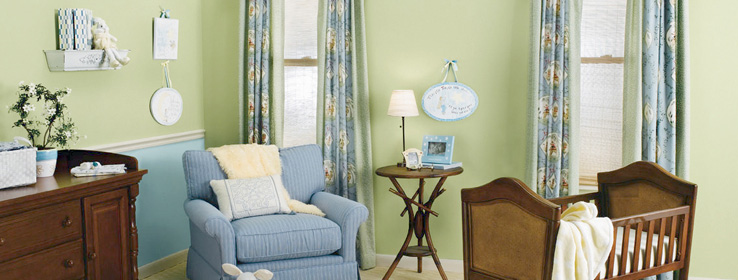Tips for designing rooms that are practical yet appealing, fun yet functional — and adaptable for years to come.
A child's room can be a challenge, especially if the plan is for the décor to have longevity. Here are some ideas for designing a room that'll thrill a young child yet still be versatile enough for any 'tween or teen.
Make an impact with bright, vibrant tones. Think of fun, sophisticated colors that easily transition from birth to early childhood to the teens and beyond, for example, aqua, tangerine or celery paired with cocoa brown or warm tan. Bright colors on the wall make a nice backdrop for more neutral furnishings and accessories.
Go beyond stereotypical colors. Many designers are getting away from the stereotypical yellows, blues and pinks that used to color nearly every child's bedroom. An all-pink room may be perfect for a little girl who loves princesses, but it may become an eyesore to that same girl and her parents when she's older. A compromise: Consider working with her favorite tone of pink, but add some lime green, sunshine yellow and sky blue for balance and to provide flexibility for the future.
Paint the room a neutral color, with one bright anchor wall or a single, thick, vertical stripe in a color of the child's choosing. Add hits of bright primary colors for accent, such as throw cushions, toys, storage bins, art and lamps – items that can easily be traded out as the child's tastes change. And don't forget to consider paint sheen. A good choice is an eggshell or satin to minimize the appearances of dirt and stains, which are almost inevitable in a child's room.
Choose multipurpose furniture. Help parents make intelligent furniture decisions by suggesting pieces that can serve double duty. A changing table that turns into a dresser can last for years, and an armoire that holds toys can later be used to store an older child's TV, sound system and gaming console. Look for cribs that convert into junior beds, small sofas, settees, daybeds and later twin-size beds.
"A daybed offers the look of a sofa or small settee, appealing to children as they grow," says Pam O'Hallaron, interior designer for PoshTots. "When placed against the wall, they open up the room for a stimulating area and more room for active play."
Linda Sheppard, owner of Dreamland Kids, a store for infants' and children's rooms, agrees. "Parents can spend $500 and get a good crib that will last for three years, or they can spend a little more and get a bed that lasts a lifetime." For a practical yet eclectic look, consider incorporating furniture that your client already has or that's purchased from second-hand or antique stores, such as dressers, rocking chairs, side tables, headboards, bookcases, shelving, lamps and quilts.
Skip the wallpaper. Some parents feel compelled to over-decorate their kids' rooms. Show them how saving the pattern for window treatments, décor and bedding can make future changes easier and less expensive. Solid, unpapered walls can more easily transition between décor trends with just a coat of paint.
Avoid characters or themes. Kids can change their minds about their favorite movie, TV or book character or their favorite interest – pirates, fairies, dinosaurs, horses, superheroes – several times in just one week. Help parents avoid having to redecorate the same room over and over again by convincing them to stay away from designing around a specific character, interest or theme. Show them how accessories – a strategic piece of framed art, new bedding, a shelf for showcasing a special collection – can make a child just as happy without all the hassle. If parents are adamant about incorporating a design on the walls, consider removable or reusable wall decals in designs that range from farm animals and the alphabet to art deco and Marimekko patterns.
Children change and grow. If your design plan includes a nod to the future, their rooms can do the same.








